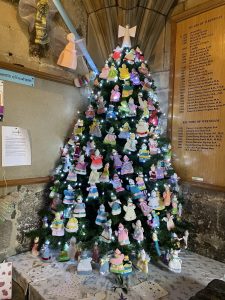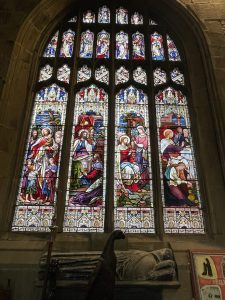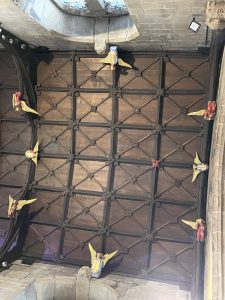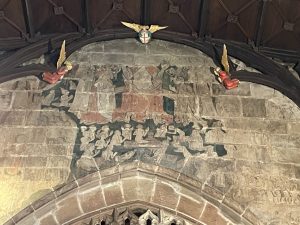St Giles church Wrexham is just down from the centre of the town, not far from Central station. Central is now a terminus – in the old days the line went on east (indeed it cut through the churchyard). Church website
https://stgilesparishchurchwrexham.org.uk/
A previous Rector is Geoffrey Marshall, who now lives in Derby and helps us out. He posted images of their angel festival on facebook, and I was really pleased to find it was still on. It has to be said that thousands of angels meant I missed some of the architectural gems of this church, but they made up for it!
This was one of the last major churches to be completed before the Reformation, so no huge changes were made as the country changed the way it worshipped. The organ went, the rood loft went, new galleries were installed in 1707, a new organ in 1779, more galleries in 1819-22 and a triple-decker pulpit – the population of the town was expanding, and the sermon was becoming the focus of the service. Elihu Yale of Plas Grono was a major benefactor (and also of Yale), as were other local men who made huge fortunes in coal, iron and brewing. New churches were built in the town – several of which closed in the C20, their treasures coming to St Giles. There was a major reordering in 2012 with the installation of a nave altar, and spaces in the aisles for meetings etc.
I made my way in through the porch and up the north aisle. Angels, and windows (but I missed the memorial window to Bishop Reginald Heber (I’ll blame the angels!).
There is something wonderfully ironic that the simple memorial tells me clearly who is remembered – a 36 year old timber merchant and carpenter. The stunning memorial is almost impossible to read. The guidebook tells me it is to Miss Mary Myddelton of Croesnewydd Hall, Wrexham, daughter of the chap who owned Chirk Castle. It is by a French sculptor, Louis Francois Roubiliac (c 1705 to 1762) – so I now know more about the chap who made it than the lady it commemorates!
The next window commemorates the tercentenary of the Royal Welch Fusiliers in 1989. It was commissioned by the regiment and designed by Joseph Nuttgens, and shows men in the different uniforms worn between 1689 and 1989, and some of their battle honours.
The War Memorial Chapel has a simple wooden altar, lovely angels, an alabaster reredos and a window of the Sermon on the Mount. It was designed by J. Eaddie Reid and made by the Gateshead Stained Glass Company of Whitley Bay.
I went up into the Chancel, through the screen probably given to the church by Elihu Yale, made by smiths Hugh and Robert Davies of Croesford. The memorial to The Reverend Thomas Myddelton and his wife Arabella is by Louis Roubiliac. The reredos was installed in 1914. The sedilia with its Green Men and other fertility symbols is C14, and was no doubt moved here from elsewhere in the church – rather lovely that they kept it and didn’t just throw it out. The Cunliffe memorial window, to George, Vicar here from 1826 to 1875 – he was born in 1795, so presumably stepped down when he hit 80. Would I have wanted another year so I could have done 50? (He died in 1884). Underneath is the effigy of Hugh Bellot, a C15 bishop – apparently he is wearing the post-Reformation attire of a Doctor of Divinity from Cambridge University. I should have got a better photo.
The Nave altar has plenty of space, and the Kings have arrived. Look up at the angels – those in the roof are C15 (though presumably well-restored), and the 2021 Festival Angels are fascinating. There are more than 6,000 of them, commemorating the 6,000 plus victims of Covid in Wales. I was told that they had some “come and make angels” workshops, and presumably many groups got involved.
The wall painting over the chancel arch is C16. It depicts the Day of Judgement and shows figures (including two kings and a bishop) wrapped in shrouds rising from their coffins to present themselves before Christ in Majesty, flanked by Mary and John. The two sides are more faded than the centre, which suggests that there might have been something (?Royal Arms) which replaced it. The whole painting was resdiscovered in 1867.
There are some lovely corbels, faces and a mermaid!
I finally turned and looked west, under the tower – and there was another “wow” moment. Whoever designed this Festival has done an incredible job – well done, and thank you.
By the west door is the grave of Elihu Yale. Born in Boston Massachusetts in 1649, he spent the last 22 years of his life near Wrexham. He was largest benefactor of Connecticut College around 1720, so they renamed the place. That’s enough – the rain started.
The museum, which is just down the road, is very good – film about the mining industry that was so important in this part of the world, fascinating display about the Roman pottery kilns and tile works on the River Dee at Holt, and an excellent cafe.





































